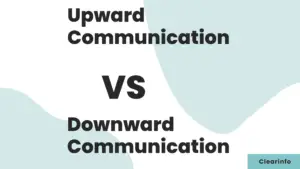In this blog, you will learn about the 8 crucial advantages and disadvantages of grapevine communication that are must to know. Along with the positive effects and challenges of grapevine communication.
What are the advantages of grapevine communication
Grapevine communication refers to the unofficial communication that occurs within an organization or social group. It is characterized by the transmission of information, rumors, and gossip through word of mouth, without following any formal channels or structures. While grapevine communication has its limitations, it also offers several advantages.
1) Rapid transmission of information: Grapevine communication operates at a fast pace. Information spreads quickly among individuals, helping to keep people updated on current events, changes in the organization, or any emerging issues. In situations where official channels might be slow or limited, the grapevine ensures that news spreads rapidly.
2) Supplement to formal communication: In organizations, formal communication channels like emails, memos, and meetings might not cover all topics or address specific concerns. The grapevine fills in these gaps by addressing issues that might not be discussed through official channels.
3) Flexibility in Communication Direction: Grapevine communication allows information to flow freely in multiple directions – upward, downward, horizontal, and diagonal. It disregards the formal hierarchy, enabling seamless interaction between individuals at all levels within the organization.
Related Reading:
4) Provides valuable feedback: Grapevine communication is beneficial as it can serve as a feedback mechanism for management. Employees or members often share their thoughts, concerns, and ideas through informal channels. This feedback can be valuable for leaders to understand the sentiments of the workforce and address any arising issues.
5) Builds trust and transparency: Encouraging open communication, even informally, can enhance trust between management and employees or group members. When leaders acknowledge and respond to grapevine discussions, it shows a commitment to transparency and can boost morale.
6) Employee satisfaction and engagement: When employees feel that their opinions and voices are heard through grapevine communication, it contributes to higher levels of job satisfaction and engagement. This, in turn, can lead to reduced turnover rates.
7) Bridges communication gaps: Grapevine communication often cuts across formal hierarchies and departments, facilitating communication between individuals who may not interact frequently in the workplace. This can promote a broader understanding of the organization and its challenges.
8) Social cohesion: Grapevine communication in an organization helps strengthen social bonds among individuals. By sharing personal experiences, interests, and concerns, employees build relationships that enhance teamwork and collaboration.
What are the disadvantages of grapevine communication
The key drawbacks of grapevine communication are highlighted in the following points:
1) Misinformation and rumors: One of the most significant demerits of Grapevine communication is the potential for spreading inaccurate information and baseless rumors. Since the information is transmitted informally and without verification, it can easily be altered as it passes from one person to another, leading to confusion and misunderstandings.
2) Lack of accountability: Since grapevine communication is informal and anonymous in nature, it lacks accountability. People may spread information without taking responsibility for its accuracy or consequences, which can lead to a breakdown of trust within the organization.
3) Distractions and reduced productivity: Excessive reliance on grapevine communication can divert employees’ or members’ attention away from their actual work. Engaging in informal gossip and discussions can decrease productivity, leading to missed deadlines and reduced efficiency.
4) Disregard for official communication: When grapevine communication is strong, employees or group members may rely more on informal sources than official channels for information. This can undermine the authority of formal communication and lead to a breakdown in organizational communication.
5) Negative impact on morale: Gossip and rumors circulating through the grapevine can negatively affect employee morale and create a toxic work environment. Unfounded rumors about layoffs, changes in leadership, or oncoming crises can generate anxiety and fear among employees.
6) Breach of confidentiality: Sensitive information might be shared on the grapevine, leading to breaches of confidentiality. This can harm the organization’s reputation and compromise its competitive advantage.
7) Resistance to change: The grapevine can perpetuate resistance to organizational change, as individuals may share negative opinions and concerns without engaging in constructive dialogue. This can prevent progress and innovation.
8) Difficulty in controlling the narrative: Organizations may find it challenging to manage or control the narrative when information is primarily shared through informal channels. Once rumors start circulating, they can be challenging to stop or correct, even with official communication efforts.
To overcome the cons of grapevine communication, organizations should focus on enhancing formal communication channels, fostering a culture of transparency, and encouraging employees to verify information before accepting or passing it along.
What are the positive effects of grapevine communication?
An organization that allows grapevine communication observes the following positive effects:
- Executives often rely on information collected through grapevine communication to make efficient business decisions and delegate work to capable workers.
- Brainstorming sessions and group discussions help employee morale by encouraging members who are not in managerial positions to share their thoughts and ideas.
- When human beings communicate with each other on an informal level, they form better bonds. This helps in increasing coordination and unity in the work environment.
What are the challenges of grapevine communication?
Grapevine communication may face the following setbacks:
- Faces the risk of distortion of messages and spreading misinformation as data is conveyed informally through non-official channels of communication.
- Informal communication can breed gossip and rumors in the workspace which is detrimental to a healthy work environment.
- It is difficult for an organization to track the source of misleading information as information communication is not documented officially.
What are the factors affecting grapevine communication?
The factors affecting grapevine communication in an organization are highlighted as follows:
- Fast mode of communication: A key characteristic of informal communication is speed. Unlike formal channels of communication which undergo a time-consuming process, informal communication is quick and spontaneous.
- Organizational climate: In the modern work culture, companies encourage their employees to communicate with each other and form friendships. This leads to increased grapevine communication in the workplace.
- Good communicators: Grapevine communication may be subjected to heavy influence by individuals who are effective communicators. These individuals can lead discussions and influence co-workers.
- Lack of formal management communication: In cases where communication from formal management in a company is unclear or lacking relevant information, employees may grow skeptical and rely more on grapevine communication to supplement formal communication.
What are the advantages of Informal communication?
Informal communication provides the following benefits to an organization:
1) It is a flexible, dynamic, and spontaneous form of communication that does not follow the hierarchical chain of command in the organization.
2) Informal communication creates a friendly workspace as it helps employees in forming friendships and stronger bonds with their co-workers.
What are the disadvantages of Informal Communication?
The disadvantages of informal communication are as follows:
1) Informal channels of communication are more likely to be used to spread misleading information, false stories, rumors, gossip, etc.
2) It is difficult for managers to monitor informal communication channels as they are not documented and recorded. This makes it difficult to track the original source of information.
To know more check out our detailed guide on the benefits and limitations of informal communication.
Frequently Asked Questions
Q1: What is grapevine communication and its importance?
Ans: Grapevine communication relies on messages being spread using informal means of communication (conversations, text messages, etc) which are unstructured and not controlled by the management. It is beneficial to an organization as it is a multidirectional and speedy form of communication that improves morale, and builds strong networks and coordination among workers.
Q2) What kind of communication is grapevine?
Ans: Grapevine communication does not follow the organizational hierarchy and observes multidirectional flow (vertical, horizontal, and diagonal). Therefore, it falls under the umbrella of informal communication.
Q3) Grapevine communication is also known as?
Ans: Grapevine communication is also commonly referred to as informal communication.
Q4) What are the features of grapevine communication?
Ans: Grapevine communication is a fast, informal, and flexible form of communication. It uses informal communication channels to relay messages between the sender and receiver. The contents of grapevine communication are not documented and monitored by the organization.



